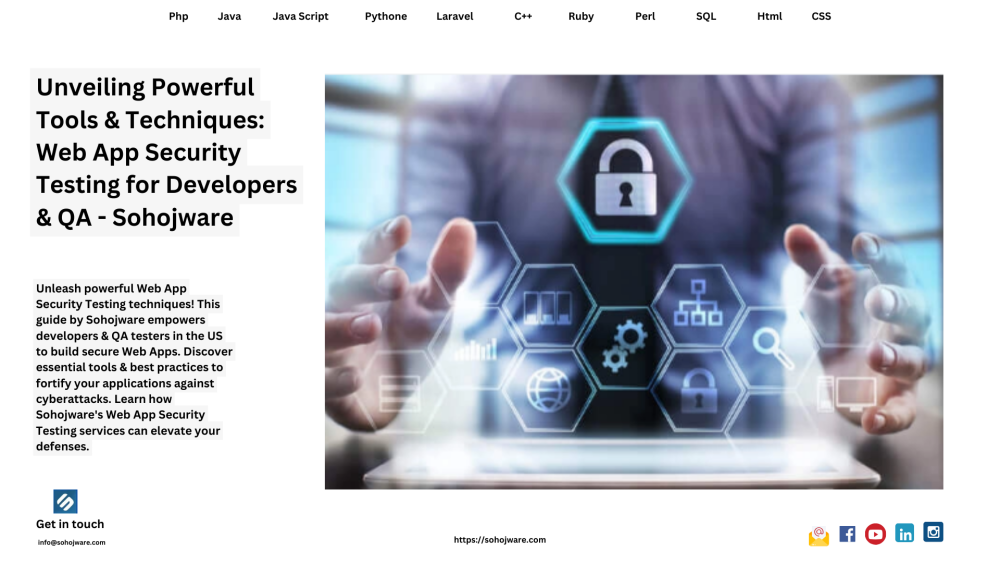In today's digital landscape, where web applications (Web Apps) are the backbone of countless businesses, security is paramount. Web Apps hold sensitive information, from user login credentials to financial data, making them prime targets for cyberattacks. For developers and QA testers, Web App Security Testing becomes a crucial line of defense. By proactively identifying and eliminating vulnerabilities, you can ensure your Web Apps are fortresses, not open doors for malicious actors.
This article by Sohojware, a leading provider of software development services, dives deep into the world of Web App Security Testing. We'll unveil powerful tools and techniques to empower developers and QA testers to build robust and secure Web Apps.
Why is Web App Security Testing Important?
Imagine the chaos that could ensue if a hacker infiltrated your Web App. Data breaches, financial losses, and reputational damage are just a few of the potential consequences. Web App Security Testing helps mitigate these risks by:
-
Identifying vulnerabilities: Security testing tools can scan your Web App for weaknesses that attackers might exploit. These vulnerabilities can include coding errors, configuration mistakes, and security misinterpretations.
-
Prioritizing risks: Not all vulnerabilities are created equal. Security testing helps you prioritize the most critical ones to fix first, focusing your efforts where they matter most.
-
Verifying fixes: Once you've addressed a vulnerability, security testing helps ensure the fix is effective and hasn't introduced new weaknesses.
-
Building a security culture: By integrating security testing into your development process, you create a culture of security awareness within your team. This proactive approach helps prevent vulnerabilities from being introduced in the first place.
Unveiling Powerful Web App Security Testing Tools
The good news is that many powerful Web App Security Testing tools are available, catering to different needs and budgets. Here are a few popular options:
-
Static Application Security Testing (SAST) Tools: These tools analyze your code without a running application. SAST tools can identify common coding errors and security vulnerabilities.
-
Dynamic Application Security Testing (DAST) Tools: DAST tools simulate real-world attacks on your running Web App. This helps identify vulnerabilities that SAST tools might miss, such as SQL injection and cross-site scripting (XSS) flaws.
-
Interactive Application Security Testing (IAST) Tools: IAST tools combine elements of SAST and DAST, providing a more comprehensive view of your Web App's security posture.
-
API Security Testing Tools: As APIs become increasingly critical for Web Apps, there's a growing need for dedicated API security testing tools. These tools can identify vulnerabilities specific to APIs.
Beyond the Tools: Essential Techniques for Developers & QA
While security testing tools are invaluable, true Web App security goes beyond automation. Here are some crucial techniques for developers and QA testers:
-
Threat Modeling: Identify potential threats and attacks your Web App might face. This helps you prioritize your testing efforts and focus on the most likely attack vectors.
-
Secure Coding Practices: Developers should be well-versed in secure coding practices to minimize the introduction of vulnerabilities in the first place. This includes techniques like input validation and proper data sanitization.
-
Security Reviews: Regular code reviews with a security lens can help identify and address vulnerabilities early in the development process.
-
Staying Up to Date: The cybersecurity landscape is constantly evolving. Developers and QA testers should stay updated on the latest threats and vulnerabilities to ensure their testing remains effective.
Partnering with Sohojware for Robust Web App Security
At Sohojware, we understand the critical importance of Web App security. Our team of experienced developers and QA testers is well-equipped with the latest tools and techniques to ensure your Web Apps are built with security in mind. We offer a comprehensive range of Web App Security Testing services, including:
-
Security assessments and penetration testing
-
Vulnerability scanning and remediation
-
Secure coding training for developers
-
Ongoing security monitoring and maintenance
By partnering with Sohojware, you can gain peace of mind knowing your Web Apps are secure and resilient. Contact us today to discuss your specific needs and how we can help you build a strong defense against cyber threats.
Conclusion
Web App Security Testing is an ongoing process, not a one-time fix. By embracing a security-conscious development culture, utilizing powerful tools and techniques, and partnering with experienced professionals like Sohojware, you can ensure your Web Apps are security fortresses, protecting your valuable data and reputation.
FAQ’s
- I'm a developer new to Web App Security Testing. Where do I start?
Web App Security Testing can seem daunting at first, but there are resources available to help you get started. Sohojware recommends familiarizing yourself with the OWASP. Additionally, many security testing tools offer free trials or limited-functionality versions that allow you to experiment and learn the ropes. Sohojware also offers secure coding training programs to empower developers with the knowledge to write secure code from the ground up.
-
What are some common mistakes developers make regarding Web App Security?
One of the most frequent mistakes is overlooking the importance of input validation. Failing to properly validate user input can leave your Web App vulnerable to attacks like SQL injection and XSS. Another common mistake is neglecting to keep software libraries and frameworks up-to-date. Outdated software often contains known vulnerabilities that attackers can exploit. Sohojware's security assessments can help identify these and other security misconfigurations in your Web Apps.
-
How often should I conduct Web App Security Testing?
Web App Security Testing should be integrated throughout the development lifecycle, not just as a one-time pre-launch activity. Sohojware recommends incorporating security testing into your development process at key stages, such as after code commits, during integration testing, and before deployment. Additionally, regular penetration testing (pentesting) by a qualified security professional is crucial to identify vulnerabilities that automated tools might miss. Sohojware offers copen-testing pen-testing services to ensure your Web Apps are thoroughly evaluated for security weaknesses.
-
What are the benefits of partnering with Sohojware for Web App Security Testing?
Sohojware brings a wealth of experience and expertise to the table. Our team of developers and QA testers are highly skilled in the latest Web App Security Testing tools and techniques. We offer a comprehensive suite of services, from security assessments and vulnerability scanning to secure coding training and ongoing security monitoring. Partnering with Sohojware allows you to focus on your core business while we handle the critical task of safeguarding your Web Apps.
-
How can I get started with Sohojware's Web App Security Testing services?
Sohojware is committed to helping you build secure and reliable Web Apps. Contact us today for a free consultation to discuss your specific needs and how our Web App Security Testing services can help you achieve your security goals. Visit our website Sohojware learn more about our services and expertise.




